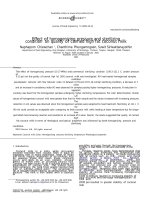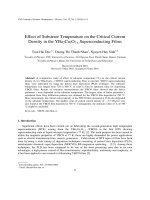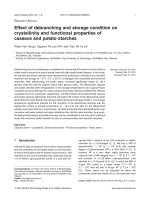Adaptogenic (Anti-Stress) effect of aqueous Musanga cecropioides (Urticaceae)
Bạn đang xem bản rút gọn của tài liệu. Xem và tải ngay bản đầy đủ của tài liệu tại đây (263.76 KB, 8 trang )
������������������������������������������������������������������������������������������������������������������������������������������������������������������������������������������������������������������������������������������������������������������������������������������������������������������������������������������������������������������������������������������������������������������������������������������������������������������������������������������������������������������������������������������������������������������������������������������������������������������������������������������������������������������������������������������������������������������������������������������������������������������������������������������������������������������������������������������������������������������������������������������������������������������������������������������������������������������������������������������������������������������������������������������������������������������������������������������������������������������������������������������������������������������������������������������������������������������������������������������������������������������������������������������������������������������������������������������������������������������������������������������������������������������������������������������������������������������������������������������������������������������������������������������������������������������������������������������������������������������������������������������������������������������������������������������������������������������������������������������������������������������������������������������������������������������������������������������������������������������������������������������������������������������������������������������������������������������������������������������������������������������������������������������������������������������������������������������������������������������������������������������������������������������������������������������������������������������������������������������������������������������������������������������������������������������������������������������������������������������������������������������������������������������������������������������������������������������������������������������������������������������������������������������������������������������������������������������������������������������������������������������������������������������������������������������������������������������������������������������������������������������������������������������������������������������������������������������������������������������������������������������������������������������������������������������������������������������������������������������������������������������������������������������������������������������������������������������������������������������������������������������������������������������������������������������������������������������������������������������������������������������������������������������������������������������������������������������������������������������������������������������������������������������������������������������������������������������������������������������������������������������������������������������������������������������������������������������������������������������������������������������������������������������������������������������������������������������������������������������������������������������������������������������������������������������������������������������������������������������������������������������������������������������������������������������������������������������������������������������������������������������������������������������������������������������������������������������������������������������������������������������������������������������������������������������������������������������������������������������������������������������������������������������������������������������������������������������������������������������������������������������������������������������������������������������������������������������������������������������������������������������������������������������������������������������������������������������������������������������������������������������������������������������������������������������������������������������������������������������������������������������������������������������������������������������������������������������������������������������������������������������������������������������������������������������������������������������������������������������������������������������������������������������������������������������������������������������������������������������������������������������������������������������������������������������������������������������������������������������������������������������������������������������������������������������������������������������������������������������������������������������������������������������������������������������������������������������������������������������������������������������������������������������������������������������������������������������������������������������������������������������������������������������������������������������������������������������������������������������������������������������������������������������������������������������������������������������������������������������������������������������������������������������������������������������������������������������������������������������������������������������������������������������������������������������������������������������������������������������������������������������������������������������������������������������������������������������������������������������������������������������������������������������������������������������������������������������������������������������������������������������������������������������������������������������������������������������������������������������������������������������������������������������������������������������������������������������������������������������������������������������������������������������������������������������������������������������������������������������������������������������������������������������������������������������������������������������������������������������������������������������������������������������������������������������������������������������������������������������������������������������������������������������������������������������������������������������������������������������������������������������������������������������������������������������������������������������������������������������������������������������������������������������������������������������������������������������������������������������������������������������������������������������������������������������������������������������������������������������������������������������������������������������������������������������������������������������������������������������������������������������������������������������������������������������������������������������������������������������������������������������������������������������������������������������������������������������������������������������������������������������������������������������������������������������������������������������������������������������������������������������������������������������������������������������������������������������������������������������������������������������������������������������������������������������������������������������������������������������������������������������������������������������������������������������������������������������������������������������������������������������������������������������������������������������������������������������������������������������������������������������������������������������������������������������������������������������������������������������������������������������������������������������������������������������������������������������������������������������������������������������������������������������������������������������������������������������������������������������������������������������������������������������������������������������������������������������������������������������������������������������������������������������������������������������������������������������������������������������������������������������������������������������������������������������������������������������������������������������������������������������������������������������������������������������������������������������������������������������������������������������������������������������������������������������������������������������������������������������������������������������������������������������������������������������������������������������������������������������������������������������������������������������������������������������������������������������������������������������������������������������������������������������������������������������������������������������������������������������������������������������������������������������������������������������������������������������������������������������������������������������������������������������������������������������������������������������������������������������������������������������������������������������������������������������������������������������������������������������������������������������������������������������������������������������������������������������������������������������������������������������������������������������������������������������������������������������������������������������������������������������������������������������������������������������������������������������������������������������������������������������������������������������������������������������������������������������������������������������������������������������������������������������������������������������������������������������������������������������������������������������������������������������������������������������������������������������������������������������������������������������������������������������������������������������������������������������������������������������������������������������������������������������������������������������������������������������������������������������������������������������������������������������������������������������������������������������������������������������������������������������������������������������������������������������������������������������������������������������������������������������������������������������������������������������������������������������������������������������������������������������������������������������������������������������������������������������������������������������������������������������������������������������������������������������������������������������������������������������������������������������������������������������������������������������������������������������������������������������������������������������������������������������������������������������������������������������������������������������������������������������������������������������������������������������������������������������������������������������������������������������������������������������������������������������������������������������������������������������������������������������������������������������������������������������������������������������������������������������������������������������������������������������������������������������������������������������������������������������������������������������������������������������������������������������������������������������������������������������������������������������������������������������������3±0.79
and 61.73±0.95.
Also, Spleen constricts to release more blood
cells (RBC and WBC) during stress, so their
weights decrease in stress (Pawar and Hugar,
2012). This stress induced changes were
significantly reversed by the test extract at
lower and higher doses. The results of the
urinary ascorbic acid obtained are in line with
several studies which reported that the tissue
levels of ascorbic acid decreased on
application of stress (Kutlu and Forbes,
1993).
2561
Int.J.Curr.Microbiol.App.Sci (2019) 8(10): 2558-2565
Table.1 The effect of Diazepam and M. cecropioides on biological parameters
in forced swim test
Groups
Groups
Tags
1
Stressed
Control
Unstressed
Control
Diazepam
(1mg/kg)
Test
(100mg/kg)
Test
(200mg/kg)
Test
(300mg/kg)
2
3
4
5
6
Biochemical/pathological parameters
Glucose
WBC
24hrs
Urinary
(mg/dL)
Ascorbic
Acid
(μg/kg/24hrs)
78.83±0.28 25429.3±0.59 76.17±0.39
73.8±0.24
22205±0.38
121.67±0.19
68.17±0.08
16125±0.09
150.83±0.63
67.19±0.29
18718.33±0.42 122.17±0.28
60±0.08
18183.83±0.38 140.67±0.47
61±0.96
15911.69±0.71 148.5±0.08
Data represent means ± S.E of 6 rats during the 5minute test session. Comparisons were made by using a one-way
ANOVA, followed by T-test P < 0.05 was considered to be statistically significant
Table.2 The effect of Diazepam and M. cecropioides on biological parameters in Chronic Cold
Resistant Stress Test
Group
Groups Tags
1
Unstressed
Control
Stressed
Control
Diazepam
(1mg/kg)
Test
(100mg/kg)
Test
(200mg/kg)
Test
(300mg/kg)
2
3
4
5
6
Biochemical/haematological parameters
Glucose
WBC
24hrs
Urinary
Ascorbic
Acid
(μg/kg/24hrs)
72.6±0.88
17300±0.27
121.38±0.41
106±0.07
19330±0.09
73.26±0.17
71.33±0.84
15030±0.52
142.11±0.71
65.5±0.28
16381.6±0.77
110.17±0.82
54.33±0.79
10451.67±0.28 124.67±0.62
61.73±0.95
10350±0.82
128.68±0.09
Data represent means ± S.E of 6 rats during the 5minute test session. Comparisons were made by using a one-way
ANOVA, followed by T-test P < 0.05 was considered to be statistically significant.
2562
Int.J.Curr.Microbiol.App.Sci (2019) 8(10): 2558-2565
Fig.1 The effect of Diazepam and M. cecropioides on swimming times in
rat using forced swim test
Data represent means ± S.E of 6 rats during the 5minute test session. Comparisons were made by using a one-way
ANOVA, followed by T-test P < 0.05 was considered to be statistically significant
Fig.2 The effect of Diazepam and M. cecropioides on swimming times in anorexia stress
tolerance test
Data represent means ± S.E of 6 rats during the 2 hrs test session. Comparisons were made by using a one-way
ANOVA, followed by T-test P < 0.05 was considered to be statistically significant
Fig.3 The antioxidant effect of aqueous extract of M. cecropioides using DPPH scavenging
activity
Effect of the extract on anoxic stress
tolerance test
In anorexia stress tolerance test Group I
(control) treated with distilled water (1mL)
was kept in hermetic vessel to for 28.80 ±0.38
min. Animals treated with diazepam (1mg/kg)
standard survived in hermetic vessel for 74.26
min; the test groups animals with varying
concentrations (100, 200, and 300mg/kg)
2563
Int.J.Curr.Microbiol.App.Sci (2019) 8(10): 2558-2565
survived in hermetic vessel for 46.48±0.28,
51.28±0.09 and 53.84±0.63 min respectively.
Effect of the extract DPPH
scavenging antioxidant activity
radical
DPPH is an oxidizing agent that can be
reduced in the presence of an antioxidant, the
stable DPPH can thus be used to quantify and
compare the free radical scavenging
capacities of different antioxidants (Yu,
2001). In this research, the aqueous extract
the plant was found to possess impressive
antioxidant capacity in a dose dependent
manner comparable to that of ascorbic acid as
depicted in figure 3.
In conclusion, the aqueous extract showed
impressive antistress potential and this present
study present as far as is known, is the first
report of the antistress (adaptogenic) activities
of M. cecropioides, this findings have added
to the many scientific proven biological
activities of M. cecropioides.
Acknowledgment
To God be the glory, the authors wish to
thank the management of Pax Herbal Clinic
and Research Laboratories for the facilities
offered and also grateful to prof. J.I Okogun
and prof. B.A Ayinde for their support.
References
Adeneye AA, Ajagbonna OP, Ayodele OW
(2007). Hypoglyceamic and antidiabetic
activities of the aqueous and ethanolic
extracts of Musanga cecropioides in
normal and Alloxan induced diabetic
rats. Fitoterapia 78(7-8): 502-505.
Adeneye,
A.A.,
Ajagbonna,
O.P.,
Mojiminiyi, F.B.O., Odigie, I.P., Etarrh,
R.R., Ojobor, P.D., Adeneye, A.K.,
2006. The hypotensive mechanisms for
the aqueous extract of Musanga
2564
cecropioides stem bark in rats. J.
Ethnopharmacol. 106, 203–207.
Ahmad. G, Yusuf Amin K.M, Khan A.N, The
anti-stress activity of a gem-containing
Unani formulation against diverse
stressors, Ethanopharmacol J, Volume
59, 1998, Pages 187-192.
Ayinde BA, Omogbai EKI, Onwukaeme DN
(2003). Pharmacognostic characteristics
and hypotensive effect of the stem bark
of Musanga cecropioides R.Br.
(Moraceae). West Afr. J. Pharmacol.
Drug Res. 19: 37-41.
Ayinde BA, Onwukaeme DN, Nworgu ZAM
(2006). Oxytoxic effects of the water
extract on Musanga cecropioides R.
Brown (Moraecae) stem bark. Afr. J.
Biotechnol. 5: 1350-1354.
Ayinde BA, Onwukaeme DN, Omogbai EKI
(2007): Isolation and characterization of
two phenolic compounds from the stem
bark of Musanga cecropioides R.
Brown (Moraceae). Acta Pol. Pharm.
64: 183-185.
Ayinde, B.A., Omogbai, E.K.I. and
Onwukaeme, D.N. (2009). Hypotensive
effects of 3, 4-dihydroxybenzyaldehyde
isolated from the stem bark of Musanga
cecropioides. J of Pharmacognosy and
Phytotherapy Vol. 1(1) pp. 004-009.
Bunkill, H.M. 1985. In: Farinhes, A.-D.
(Ed.), The Useful Plants of West
Tropical Africa, vol. 1, 2nd ed. Royal
Botanical Gardens, Kew, pp.346–349.
Dongmo, A.B., Kamanyi, A., Bopelet, M.
1996. Saponins from the leaves of
Musanga cecropioides (Cecropiaceae)
constitute a possible source of potent
hypotensive principles. Phytother. Res.
10, 23–27.
Gill L S. Ethnomedical uses of plants in
Nigeria. Uniben Press, Benin City.1992:
170.
Gülçin, I., E. Kireçci, E. Akkemik, F. Topal
and O. Hisar. 2010, Antioxidant and
antimicrobial activities of an aquatic
Int.J.Curr.Microbiol.App.Sci (2019) 8(10): 2558-2565
plant: duckweed (Lemna minor L.).
Turkish Journal of Biology, 34 (2):
175:188.
Irvine FR (1961): Wood plants of Ghana.
Oxford University Press, London
pp.446-447.
Kamanyi A, Bopelet M, Tatchum TR (1992):
Contractile effect of some extracts from
the leaves of Musanga cecropioides
(Cecropiaceae) on uterine smooth
muscle of the rat. Phytother. Res. 6:
165-167
Kenjale R.D, Shah R.K, Sathaye S.S, Antistress and anti-oxidant effects of roots
of Chlorophytum borivilianum, Indian J
Exp Biol, Volume 45, 2007, Pages 974979
Kutlu HR, Forbes JM: Changes in growth and
blood parameters in heat stressed broiler
chicks in response to dietary ascorbic
acid. Liverstock Prod Sci., 1993, 36:
335-350.
Lontsi D, Sondengam BL, Bodo B, Martin
MT (1998a): Kalaic acid, a new Ursane
– type Saponin from Musanga
cecropioides. Planta Med. 64: 189-191
M. Arif, S. Fareed, T. Hussain, and M. Ali,
“Adaptogenic activity of lanostane
triterpenoid isolated from Carissa
carandas fruit against physically and
chemically challenged experimental
mice,” Pharmacognosy Journal, vol. 5,
no. 5, pp. 216–220, 2013.
Mulay, M. Evaluation of herbals for
adaptogenic activity. M. Tech Thesis,
university of Mumbai, Mumbai India,
2004.
Orwa C, A Mutua, KindtR, Jamnadass R, S
Anthony. 2009 Agroforestree Database:
a tree reference and selection guide
version 4.0
Pawar, V.S. and S. Hugar, “Adaptogenic
activity of Trigonella foenumgraecum
(Linn) seeds in rodents exposed to
anoxia and immobilization stress,”
Asian Pacific Journal of Tropical
Biomedicine, vol. 2, pp. S208–S211,
2012.
S. Puri, B. Kumar, J. Debnath et al.,
“Comparative
pharmacological
evaluation of adaptogenic activity of
Holopteleainte grifolia and Withania
somnifera,” International Journal of
Drug Development and Research, vol.
3, no. 1, pp. 84–98, 2011.
Selye, H. Syndrome produced by diverse
nocuous agents. J. Neuropsy chiatry
Clin Neurosci., 1998, 10: 230-231.
Singh, B., B.K. Chandan and D.K. Gupta,
“Adaptogenic activity of a novel with
anolide-free aqueous fraction from the
roots of Withania somnifera Dun. (Part
II),” Phytotherapy Research, vol. 17, no.
5, pp. 531–536, 2003.
Yu L. Free radical scavenging properties of
conjugated linoleic acid. Journal
Agricultural Food Chemistry. 2001;
49:3452- 3456
How to cite this article:
Tunde A. Owolabi, K.C. Ezenwa, E.Y. Olayioye, O.C. Iyorhibe, E. Amodu, O.F. Aferuan, P.C.
Okubor, B.A. Ayinde and Okogun, J.I. 2019. Adaptogenic (Anti-Stress) Effect of Aqueous
Musanga cecropioides (Urticaceae). Int.J.Curr.Microbiol.App.Sci. 8(10): 2558-2565.
doi: />
2565









